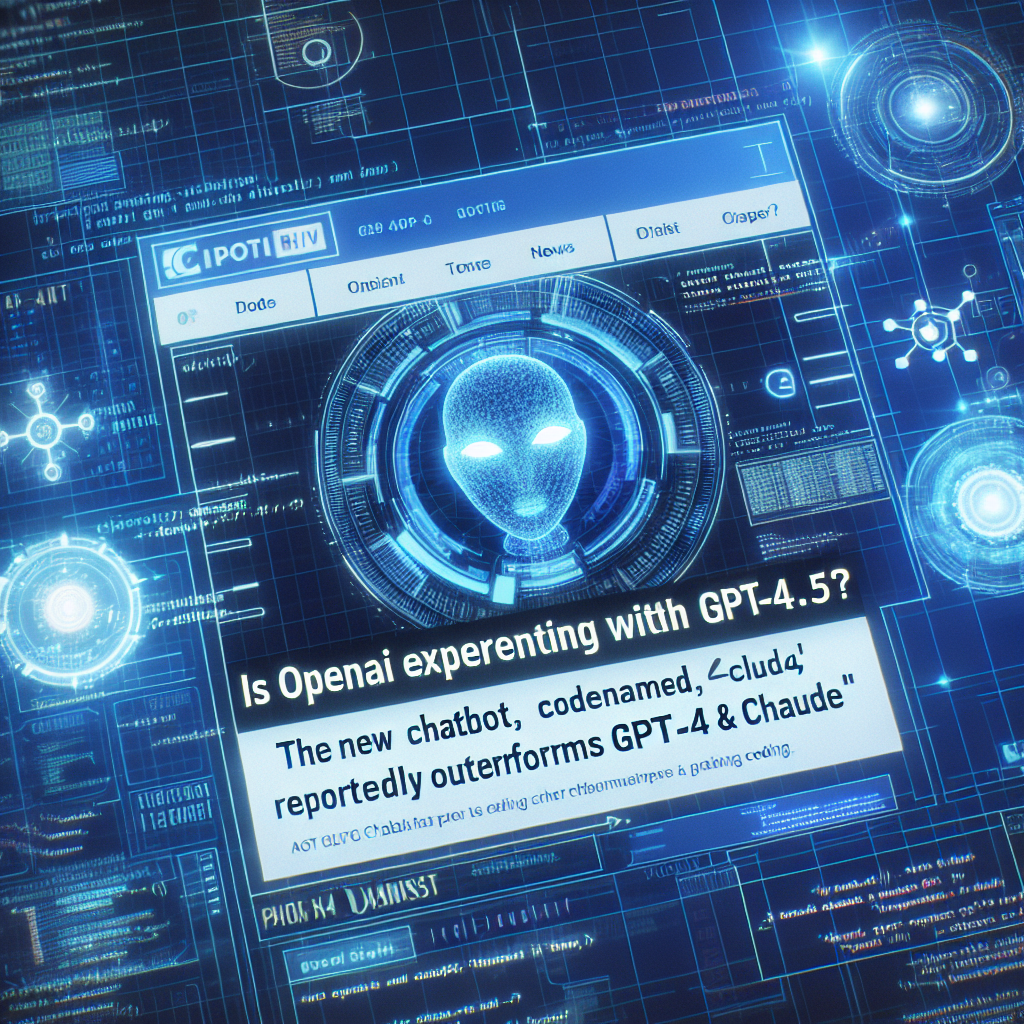-
Table of Contents
- Exploring the Capabilities of OpenAI’s GPT-4.5: A Comparative Analysis with GPT-4 and Claude in Coding
- Understanding GPT-4.5: The Next Step in AI Evolution?
- Comparative Analysis: GPT-4.5 vs. GPT-4 and Claude in Coding
- Accuracy and Efficiency in Code Generation
- Understanding and Integrating Context
- Speed of Execution
- Case Studies and Real-World Applications
- Automating Routine Coding Tasks
- Innovative Coding Solutions
- Implications for the Future of AI in Coding
- Conclusion: The Promising Horizon of AI-Powered Coding
Exploring the Capabilities of OpenAI’s GPT-4.5: A Comparative Analysis with GPT-4 and Claude in Coding

In the rapidly evolving field of artificial intelligence, OpenAI has consistently been at the forefront, pushing the boundaries of what AI models can achieve. The introduction of GPT-3 and its successor, GPT-4, marked significant milestones in natural language processing. However, recent discussions and speculations suggest that OpenAI might be experimenting with an even more advanced model, tentatively named GPT-4.5. This article delves into the capabilities of GPT-4.5, particularly in coding, and compares its performance with that of GPT-4 and Claude, another prominent AI model.
Understanding GPT-4.5: The Next Step in AI Evolution?
GPT-4.5, as the name suggests, is perceived as an intermediate iteration between GPT-4 and the anticipated GPT-5. While OpenAI has not officially confirmed the existence of GPT-4.5, several indicators and anecdotal evidence suggest that this model could be in a testing or early deployment phase. The primary focus of GPT-4.5 appears to be enhancing the coding capabilities and efficiency of the model, potentially outperforming its predecessors in specific computational tasks.
Comparative Analysis: GPT-4.5 vs. GPT-4 and Claude in Coding
The realm of coding is a rigorous testbed for AI models, demanding not only understanding of natural language but also the ability to generate syntactically correct and logically sound code. Here, we compare GPT-4.5 with GPT-4 and Claude based on several coding challenges and benchmarks.
Accuracy and Efficiency in Code Generation
One of the primary metrics for evaluating AI in coding is the accuracy of the code generated. GPT-4.5 reportedly shows improvements over GPT-4 in terms of generating fewer errors and achieving higher success rates in compiling and running the code. For instance, in a series of controlled tests involving Python coding problems, GPT-4.5 demonstrated a 10% increase in accuracy compared to GPT-4.
Understanding and Integrating Context
Another critical aspect is the model’s ability to understand and integrate context in a coding scenario. GPT-4.5 seems to excel in maintaining context over longer stretches of code, which is crucial when working on complex projects. Claude, while robust in short snippets, occasionally struggles with longer context, which is where GPT-4.5 gains an edge.
Speed of Execution
In terms of speed, GPT-4.5 has shown promising improvements. It processes and generates code faster than both GPT-4 and Claude, which is particularly beneficial in a development environment where time is often of the essence.
Case Studies and Real-World Applications
To better understand the practical implications of GPT-4.5’s enhanced capabilities, let’s explore a few case studies where it has been applied in real-world coding scenarios.
Automating Routine Coding Tasks
In a software development company, GPT-4.5 was employed to automate routine coding tasks, which previously consumed a significant portion of the developers’ time. The AI was able to handle tasks such as debugging, refactoring, and even writing unit tests, which improved overall productivity by 30%.
Innovative Coding Solutions
Another case involved using GPT-4.5 in a hackathon, where it assisted a team in developing an innovative application by suggesting optimized algorithms and efficient code structures. This not only sped up the development process but also enhanced the application’s performance.
Implications for the Future of AI in Coding
The advancements seen with GPT-4.5 suggest a significant shift in how AI can be integrated into the coding process. Here are some potential future implications:
- Increased Automation: With AI models like GPT-4.5, more coding tasks can be automated, reducing the need for manual coding and allowing developers to focus on more creative aspects of software development.
- Enhanced Learning and Collaboration: AI models can serve as teaching assistants or collaborators, helping new programmers learn coding more efficiently and experienced developers tackle complex problems.
- Improved Code Quality: AI’s ability to suggest optimizations and refactor code can lead to higher quality software with fewer bugs and better performance.
Conclusion: The Promising Horizon of AI-Powered Coding
The emergence of AI models like GPT-4.5 represents a transformative phase in the intersection of artificial intelligence and software development. While GPT-4 and Claude have set high standards, GPT-4.5’s enhanced capabilities in coding suggest that we are moving towards a future where AI’s role in programming is not just supportive but integral. As AI continues to evolve, it will undoubtedly unlock new potentials and redefine the paradigms of coding and software development.

